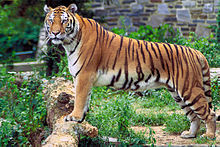Owing to the varying altitude from the Himalayas to the coastal plains, the flora and fauna of the state is diverse. Forests make up 14% of the geographical area of West Bengal, which is lower than the national average of 23%. Protected forests cover 4% of the state area. Part of the world's largest mangrove forest Sundarbans is located in southern West Bengal.
| Union day | August 18 (Day of accession to India) | |
| State animal | Bengal Tiger |  |
| State bird | White-throated Kingfisher | |
| State tree | Devil Tree |  |
| State flower | Night-flowering Jasmine |
The Sundarbans are noted for a reserve project conserving Bengal tigers. There are five national parks in the state — Sundarbans National Park, Buxa Tiger Reserve,Gorumara National Park, Neora Valley National Park and Singalila National Park. Wildlife includes the Indian rhinoceros, Indian elephants, deer, bison, leopards, gaur, and crocodiles. The state is also rich in bird life. Migratory birds come to the state during the winter.The high altitude forests like Singalila National Park shelter barking deer, red panda, chinkara, takin, serow, pangolin, minivet and Kalij pheasants. In addition to the Bengal tiger, the Sundarbans host many other endangered species like Gangetic dolphin, river terrapin, estuarine crocodile etc. The mangrove forest also acts as a natural fish nursery, supporting coastal fishes along the Bay of Bengal.



No comments:
Post a Comment